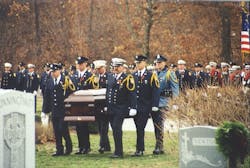FHWorld16: Safety in the Decision-Making Process
People are creatures of habit. And one could argue that firefighters may be even more rooted in their ways.
Over the past two decades, the fire service has seen an extraordinary increase in safety awareness; however, there are still many deeply entrenched habits in both firefighter training and on-scene operations that continue to shape tactics and strategy. In his Wednesday Firehouse World session “The Historic Role of Safety in the Decision-Making Process,” Worcester, MA, Fire Department Deputy Chief John Sullivan explores some of these habits and advocates ways to adjust the decision-making process to reflect a greater emphasis on firefighter safety.
In an interview before the conference, Sullivan explained that some of these habits can be seen in freelancing, air management policies, command presence, communication techniques and a lack of policies and procedures for countless fireground operations. Using air management as an example, Sullivan described that as he goes around the country talking to fire personnel from departments big and small, the same answer keeps coming up over and over again—that firefighters are using their low-air alarm as a “get-out-of-jail free” card, rather than really learning how to manage their air. And in too many cases, Sullivan said, what he hears is, “We don’t have a policy, but we usually do this [fill in the blank],” he said. “But usually doesn’t cut it. That’s not a policy.”
Sullivan explained that firefighters need to learn and evolve from past incidents, and a key to this is examining the decision-making processes involved. “In my opinion and with what I’ve seen in my experience, it really comes down to individual decision-making based on the organization’s policies and procedures,” he said. “The organizational culture must be proactive and create a situation in which company officers, chiefs and individual firefighters feel empowered by knowledge, whether that’s through a formal pre-fire plan or just general knowledge about the district or basic education from recruit school and beyond.” And then, when looking back on fires, “if you dig far enough, you can see where the organization affected the decision-making and then the actual decision made by the individual on scene.”
In the modern fire service, the organization must create policies and procedures that reflect the community’s actual needs, he said, noting that there’s not a lot that fire departments can do about the things that blind-side you, but they can prepare for the most common incidents.
Sullivan believes that, in some cases, if firefighters did the same things today that they did in years past, they could be found negligent in a court of law. “We know better now,” he said. “Back then we did what we knew, but by today’s standards, we have access to almost everyone’s policies and procedures and we know the best practices.” Additionally, he said, there are countless resources at firefighters’ disposal, ranging from conferences to magazines to educational opportunities, such as the NFA. “In this day of technology where we can look up information online or just pick up the phone and ask someone to send over the information, there’s no excuse anymore to not track down the information,” he said.
It all comes back to training and a culture of empowered decision-making, Sullivan said. “No one is improvising. You are doing what you were trained to do,” he explained. “If your department promotes decision-making and trains firefighters as decision-makers and engrains it into their psyche, then they will understand how their fireground decisions will impact the end game and how their individual decisions connect to the rest of the fireground.” He added that because firefighters don’t have as much experience as previous generations (due to declining fire numbers), solid decision-making must be taught through training, simulation and case studies.
Sullivan also noted that it’s important to understand that not all habits are bad—they are just the habitual things that we do. The key to knowing whether a habit is bad comes down the totality of the incident and how the habit connects with the other fireground operations. Sullivan used the example of horizontal ventilation. “In the past we ventilated ‘early and often,’” he said. “In some cases, this still holds true—small fires that are under the control of a properly staffed and equipped engine company. In other cases, this same habit can and has had deadly consequences (imminent flashover).”
Sullivan explained that today’s firefighters—and exponentially more so the chief—must know the big picture. “They have to be able to put a million little pieces together to make a decision, and the individual firefighter has a thousand little pieces to put together,” he said. “As you grow, your ability to sift through and analyze those pieces to make good decisions becomes more intuitive and you can better see the bigger picture.”
Perhaps the best example of an intuitive decision-maker is District Chief Michael McNamee, who in December 1999 made the decision to stop additional Worcester firefighters from entering the Worcester Cold Storage Warehouse when there were already six firefighters lost inside. “That decision is the pinnacle in courage in decision-making despite not having all the organizational help,” said Sullivan, who was a lieutenant on an engine company the night of the fire. “That’s just raw.”
As part of his Firehouse World session, Sullivan plans to detail some of the decision-making at the Worcester Cold Storage Warehouse Fire. Topics will include decision-making related to air management, large-area search training, commercial structure fire policy, fire dynamics, rapid-intervention teams, communications and more.
Note: Firehouse Magazine recently renamed its famed Heroism Award to the Michael O. McNamee Award of Valor to change firefighters’ perspectives about what it means to be brave in the face of danger—and part of that shift involves recognizing the critical role of decision-making. To learn more about the award, visit firehouse.com/article/12107642/firehouse-renames-famed-awards-program.
About the Author

Janelle Foskett
Janelle Foskett served as editorial director of Firehouse Magazine and Firehouse.com, overseeing the editorial operations for the print edition along with working closely with the Web team.
